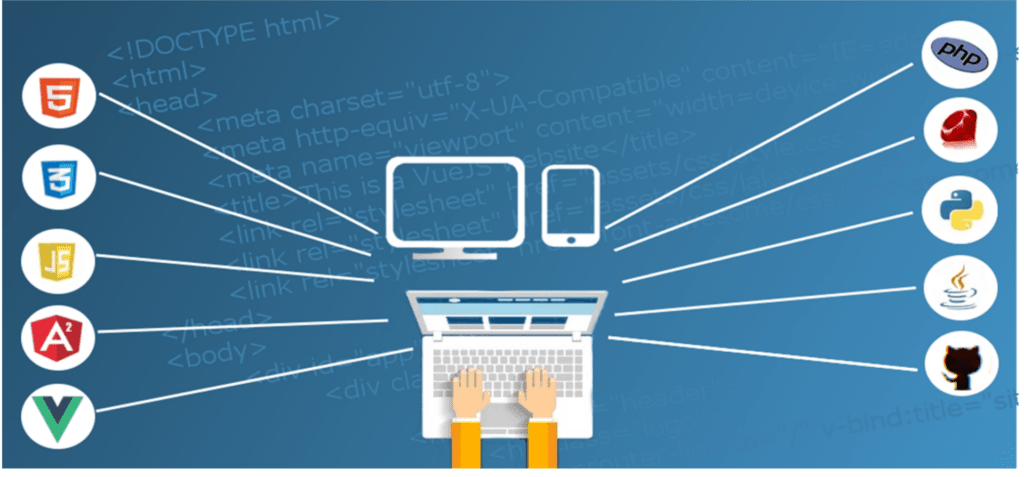In today’s technology-driven world, finding and hiring top-tier full-stack developers can be a challenging task. As companies increasingly rely on their digital presence, recruiting skilled professionals who can handle both front-end and back-end development is crucial. This blog will guide you through the process of successfully recruiting and hiring a full-stack developer. We’ll explore the essential steps, from defining your needs to assessing technical skills and evaluating cultural fit. By following these guidelines, you can increase your chances of finding the right full-stack developer who will contribute to your organization’s success.
What is a Full-Stack Developer?
A full-stack developer is a professional who possesses skills and expertise in both front-end and back-end web development. They are proficient in working with the technologies and frameworks required to handle the entire development process, from designing the user interface to implementing server-side functionalities.
Front-end development refers to the creation of the user-facing aspects of a website or application. This includes designing and developing the layout, user interface (UI), and user experience (UX) using HTML, CSS, and JavaScript. Front-end developers focus on ensuring that the website or application is visually appealing, responsive, and user-friendly.
Back-end development, on the other hand, involves handling the server side of the web application. It includes managing databases, implementing server logic, and ensuring the smooth functioning of the application. Back-end developers work with programming languages such as Java, Python, Ruby, or PHP, and frameworks like Node.js, Django, Ruby on Rails, or Laravel.
Full-stack developers have a comprehensive understanding of both front-end and back-end development. They are capable of working on all layers of a web application, including the user interface, server-side logic, and database integration. They possess a wide range of skills that allow them to handle end-to-end development tasks independently or collaborate with specialized developers in larger teams.
Skills for a Full-Stack Developer
A full-stack developer should possess a combination of technical and soft skills to effectively handle both front-end and back-end development tasks. Here are some essential skills for a full-stack developer:
1. Proficiency in Front-end Technologies:
Full-stack developers should have a strong understanding of front-end technologies, including:
– HTML: The markup language used for structuring web content.
– CSS: Cascading Style Sheets for styling and layout.
– JavaScript: The programming language for interactive and dynamic web elements.
– Front-end frameworks/libraries: Familiarity with popular frameworks like React, Angular, or Vue.js can be advantageous.
2. Back-end Development Skills:
Full-stack developers should be proficient in back-end technologies and frameworks, such as:
– Programming languages: Proficiency in one or more back-end programming languages like Python, Java, Ruby, PHP, or Node.js.
– Back-end frameworks: Knowledge of frameworks like Express.js, Django, Ruby on Rails, or Laravel for efficient server-side development.
– Databases: Experience working with relational databases (e.g., MySQL, PostgreSQL) or NoSQL databases (e.g., MongoDB, Redis).
– APIs: Understanding how to design, build, and consume APIs (REST, GraphQL) to connect front-end and back-end components.
3. Database and Server Management:
Full-stack developers should be capable of handling database management tasks and server configuration, including:
– Database management systems (DBMS): Familiarity with popular DBMSs and their query languages, such as SQL.
– Server management: Understanding server architecture, deployment, and maintenance using tools like Apache, Nginx, or Docker.
4. Version Control and Collaboration:
Full-stack developers should be comfortable working with version control systems (e.g., Git) to collaborate effectively with team members and manage code repositories.
5. Problem-solving and Debugging:
Strong problem-solving and debugging skills are crucial for full-stack developers to identify and resolve issues efficiently throughout the development process.
6. Web Security:
Understanding common web security practices, such as handling user authentication, data encryption, and protection against common vulnerabilities (e.g., XSS, CSRF), is essential for full-stack developers.
While possessing all these skills is advantageous, it’s important to note that full-stack developers may have varying levels of expertise in different areas. Some may specialize more in front-end or back-end development while having a good understanding of the other.
How to find a Full-Stack developer in Latin America
Finding a full-stack developer in Latin America follows a similar process to finding one in any other region. Here are some effective strategies to help you find a full-stack developer in Latin America:
Networking and Referrals: Tap into your professional network and seek referrals from colleagues, friends, or other industry contacts who have connections in Latin America. They may recommend skilled developers or connect you with relevant communities or groups.
Partner with Recruitment Agencies: Engage with recruitment agencies or staffing firms in Latin America that specialize in tech talent. They have expertise in identifying and vetting full-stack developers, saving you time and effort in the hiring process.
Evaluate Online Portfolios and GitHub: Review online portfolios and GitHub profiles of potential candidates to assess their previous work and coding skills. Pay attention to the quality of their projects, the technologies they have used, and their code quality.
Conduct Virtual Interviews: Conduct virtual interviews to assess the technical skills, problem-solving abilities, and cultural fit of the candidates. Use video conferencing tools to connect with potential candidates and ask relevant technical questions.
Consider Language and Time Zone Compatibility: When hiring a full-stack developer from Latin America, consider language proficiency in English or any other language required for effective communication. Also, ensure that the time zone difference does not hinder collaboration and project management.
Evaluate Cultural Fit: Assess the cultural fit of the candidates to ensure smooth integration into your team and company culture. Consider factors like work ethic, communication style, and alignment with your organization’s values.
Remember to clearly communicate your requirements, offer competitive compensation based on regional standards, and provide a detailed job description to attract the right full-stack developer for your project or organization.


